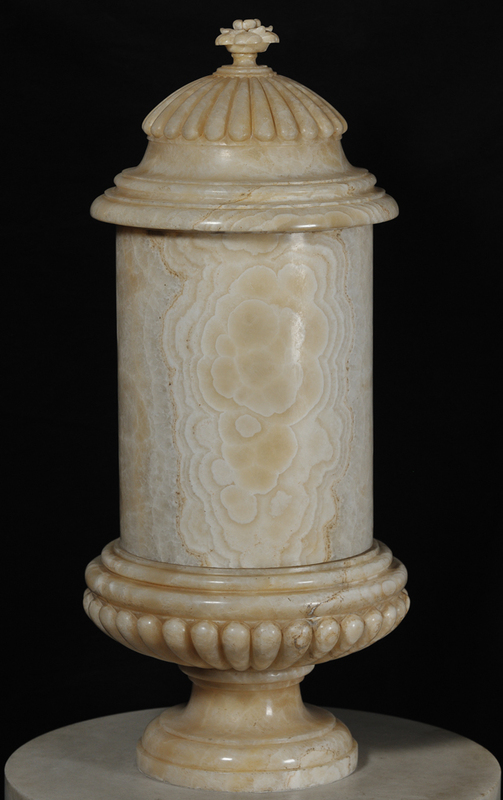Pair of Vases in Alabaster
Resting on round, moulded bases, the two vases are each characterised by a smooth cylindrical body decorated at the bottom with a type of saucer with conspicuous convex, pod-like motifs. The same decorative pattern is repeated in the lid, which protrudes noticeably over the rim and terminates in a floral knob.
The smooth surface of the body not only exalts the exquisite quality of the alabaster but also highlights the play of shadows created by the mouldings at the lower end and in the lid.
The style of the two amphorae suggest dating them to the first half of the 17th century, which is in fact confirmed by Manilli’s mention of the pair in 1650. Contemporary sources ascribed them to Silvio Calci of Velletri, yet no documentation in the Borghese Archives confirms this attribution.
Object details
Inventory
Location
Date
first half of the 17th century
Classification
Period
Medium
Dimensions
Provenance
Documented in the Borghese Collection from 1650 (Manilli, Villa Borghese, Rome 1650, p. 61); Inventory Fidecommissario Borghese, 1832, C, p. 53, no. 167. Purchased by Italian state, 1902.
Conservation and Diagnostic
- 1996/ 1998 L. Persichelli
Commentary
Each tall, cylindrical vase rises up from a circular foot composed of a fillet, echinus and cavetto and terminating in a slightly indented, reversed echinus. The body is supported by a type of saucer decorated with pod-like motifs, which culminates in double torus moulding and a fillet. The base of the lid shows a quite protruding echinus followed by cyma reversa moulding. The motif of pods in a ray arrangement is repeated at the top of the lid, which culminates in a floral knob.
The design of the vases is characterised by the conspicuous contrast between their smooth surfaces – whose decoration is left to the transparency and beautiful veining of the alabaster, ably highlighted by the sculptor – and the two moulded extremities, whose quite pronounced volumes create a lively play of shadows. This decorative style is typical of vase production in the first half of the 17th century, as is confirmed by Manilli’s description of the objects: ‘Two round vases in oriental alabaster, with feet and lids sculpted in ray patterns, four spans high’ (1650, p. 61). Several years later, Martinelli suggested ascribing them to Silvio Calci of Velletri (‘two white, transparent alabaster vases made by Silvio Calcia Velletrano’, 1664, p. 109), a name repeated by Venuti in 1766, (‘made by Silvio Velletrano’, p. 117); yet at present we possess no other documentation which either confirms or refutes this attribution.
Our sources agree that the two amphorae were first displayed in the David Room, on either side of Bernini’s sculpture. They appeared on ‘large white marble pedestals with frames of various stones and a Corinthian capital’: Manilli, 1650, p. 61). In 1786, they were reported as occupying the space above the two doors of the Egyptian Room, between Luigi Salimbeni’s plaster sphinxes (‘Descrizione’, in Giornale delle belle arti, no. 52, 30/12/1786, p. 309). Today they are displayed in the same room, though on granite blocks.
Critics disagree as to the dating of the works: while De Rinaldis believed they were executed in the early 19th century (1935, p. 316), Della Pergola placed them in the 17th (1951, p. 20). For his part, Faldi suggested the year 1780, proposing that they were specifically sculpted for the Egyptian Room; he further maintained that they were inspired by a drawing by Piranesi which appeared in the collection Vasi, Candelabri, Cippi, Sarcofagi, Tripodi, Lucerne ed ornamenti antichi, published in 1778 (Faldi 1954, pp. 22-3).
Sonja Felici
Bibliography
- I. Manilli, Villa Borghese fuori di Porta Pinciana, Roma 1650, p. 61.
- F. Martinelli, Roma ricercata nel suo sito, e nella scuola di tutti gli Antiquarii, Venezia 1664, p. 109.
- D. Montelatici, Villa Borghese fuori di Porta Pinciana con l’ornamenti che si osservano nel di lei Palazzo, Roma 1700, p. 255.
- G. P. Pinaroli, Trattato delle cose più memorabili di Roma tanto antiche come moderne, che in essa di presente si trovano, Roma 1713, II, p. 105.
- R. Venuti, Accurata, e succinta descrizione topografica, e istorica di Roma moderna, Roma 1766, p. 117.
- Giornale di Belle Arti, 52, 30 dicembre 1786, p. 309.
- L. Lamberti, E.Q. Visconti, Sculture del palazzo della Villa Borghese detta Pinciana, Roma 1796, p. 72.
- A. Venturi, Il Museo e la Galleria Borghese, Roma 1893, p. 44.
- A. De Rinaldis, Arte decorativa nella Galleria Borghese, in “Rassegna della Istruzione artistica”, 10-11-12, 1935, p. 316.
- P. Della Pergola, La galleria Borghese in Roma, Roma 1951, p. 20.
- I. Faldi, Galleria Borghese. Le sculture dal sec. XVI al XIX, Roma 1954, pp. 22-23.
- M.C. Marchei, Alabastro egiziano o cotognino, onice, in Marmi antichi, a cura di G. Borghini, Roma 1997, pp. 140-141, cat. 4.
- L. Ficacci, Giovanni Battista Piranesi: the complete etchings, Köln 2000, p. 601, fig. 760.
- P. Moreno, C. Stefani, Galleria Borghese, Milano 2000, p. 181, fig. 15 (inv. CCXXII).
- Schede di catalogo 12/01008621, 12/01008623, F. Castiglioni 1980; aggiornamento S. Felici 2020.


